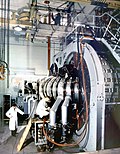Wikipedia:Today's featured article/January 25, 2019
ZETA was an early experiment in fusion power research. Built at the Atomic Energy Research Establishment in England, it was much larger and more powerful than any other fusion machine at that time. It went into operation in August 1957, and by the end of the month was giving off bursts of about a million neutrons per pulse. Measurements suggested temperatures between 1 and 5 million kelvins, hot enough to produce nuclear fusion reactions. Early results were leaked to the press, and front-page headlines announced a breakthrough. Further experiments revealed measurement errors, and the claim of fusion was publicly withdrawn, casting a chill over the entire fusion establishment. The neutrons were later explained as the product of instabilities in the fuel. ZETA went on to have a long experimental lifetime, supporting work in plasma theory and originating more accurate laser-based temperature measurements that supported the tokamak approach a decade later. (Full article...)

